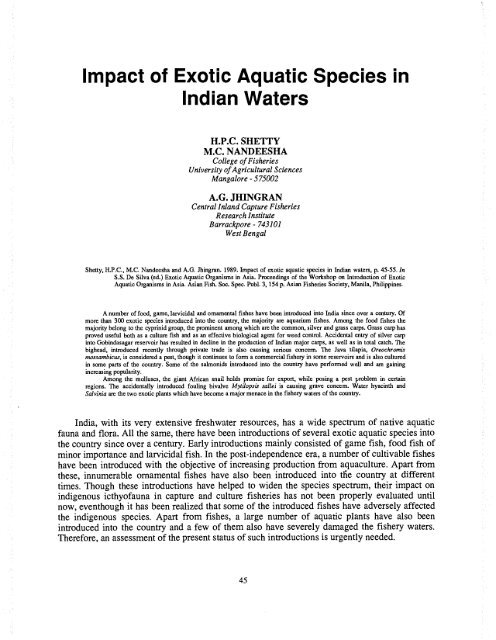Exotic Aquatic Organisms - International Development Research ...
Exotic Aquatic Organisms - International Development Research ...
Exotic Aquatic Organisms - International Development Research ...
Create successful ePaper yourself
Turn your PDF publications into a flip-book with our unique Google optimized e-Paper software.
Impact of <strong>Exotic</strong> <strong>Aquatic</strong> Species in<br />
Indian Waters<br />
H.P.C. SHETTY<br />
M.C. NANDEESHA<br />
College of Fisheries<br />
University of Agricultural Sciences<br />
Mangalore - 575002<br />
A.G. JHINGRAN<br />
Central Inland Capture Fisheries<br />
<strong>Research</strong> Institute<br />
Barrackpore - 743101<br />
West Bengal<br />
Shetty, H.P.C., M.C. Nandeesha and A.G. Thingran. 1989. Impact of exotic aquatic species in Indian waters, p. 45-55. In<br />
S.S. Dc Silva (ed.) <strong>Exotic</strong> <strong>Aquatic</strong> <strong>Organisms</strong> in Asia. Proceedings of the Workshop on Introduction of <strong>Exotic</strong><br />
<strong>Aquatic</strong> <strong>Organisms</strong> in Asia. Asian Fish. Soc. Spec. Pubi. 3, 154 p. Asian Fisheries Society, Manila, Philippines.<br />
A number of food, game, larvicidal and ornamental fishes have been introduced into India since over a centusy. Of<br />
more than 300 exotic species introduced into the country, the majority are aquarium fishes. Among the food fishes the<br />
majority belong to the cyprinid group, the prominent among which are the common, silver and grass carps. Grass carp has<br />
proved useful both as a culture fish and as an effective biological agent for weed control. Accidental entry of silver carp<br />
into Gobindasagar reservoir has resulted in decline in the production of Indian major carps, as well as in total catch. The<br />
bighead, introduced recently through private trade is also causing serious concern. The Java tilapia, Oreochromis<br />
mossambicus, is considered a pest, though it continues to form a commercial fishery in some reservoirs and is also cultured<br />
in some parts of the country. Some of the salmonids introduced into the country have peiformed well and are gaining<br />
increasing popularity.<br />
Among the molluscs, the giant African snail holds promise for export, while posing a pest problem in certain<br />
regions. The accidentally introduced fouling bivalve Mytilopsis sallei is causing grave concern. Water hyacinth and<br />
Salvinia are the two exotic plants which have become a major menace in the fishery waters of the country.<br />
India, with its very extensive freshwater resources, has a wide spectrum of native aquatic<br />
fauna and flora. All the same, there have been introductions of several exotic aquatic species into<br />
the country since over a century. Early introductions mainly consisted of game fish, food fish of<br />
minor importance and larvicidal fish. In the post-independence era, a number of cultivable fishes<br />
have been introduced with the objective of increasing production from aquaculture. Apart from<br />
these, innumerable ornamental fishes have also been introduced into the country at different<br />
times. Though these introductions have helped to widen the species spectrum, their impact on<br />
indigenous icthyofauna in capture and culture fisheries has not been properly evaluated until<br />
now, eventhough it has been realized that some of the introduced fishes have adversely affected<br />
the indigenous species. Apart from fishes, a large number of aquatic plants have also been<br />
introduced into the country and a few of them also have severely damaged the fishery waters.<br />
Therefore, an assessment of the present status of such introductions is urgently needed.<br />
45

















